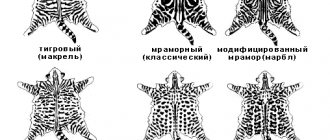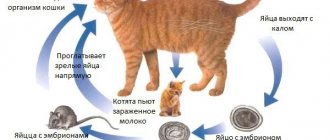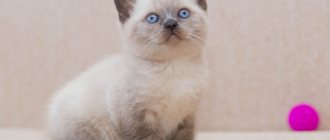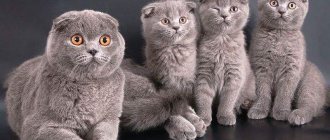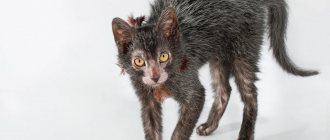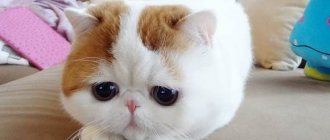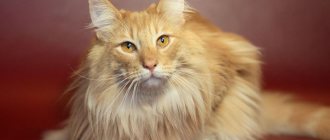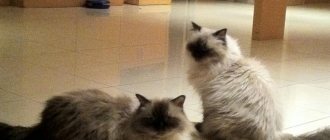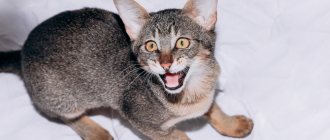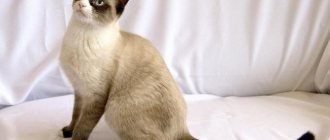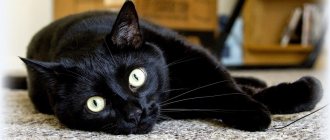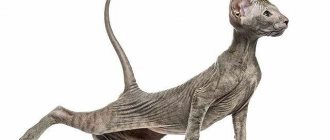Diet of exotic cats
The tendency to food allergies makes it necessary to carefully select food.
Moreover, a high class of food does not guarantee the absence of allergic reactions: eczema, inflammation of the eyes, ears, etc. Not only the components of the feed are important, but also their ratio and additional additives, which are specific to each manufacturer. So you can only determine which one is right for your pet through experience. Exotics are generally picky about food and react to unsuitable food with digestive upset. Usually high-quality feeds are well balanced and contain all the necessary substances
It is worth paying special attention to diets that promote healthy skin, strengthen the coat and have a hypoallergenic composition. They should be designed for the pet’s age and lifestyle
Usually sedentary when it comes to exotics. But any living organism is unique, and if the cat does not look brilliant, it will benefit from treats with taurine and products for removing hair from the stomach.
Exotics are fed three times a day, not forgetting to provide fresh water. The dishes must be clean - this is a requirement not for the sake of order, but because of the special sensitivity of exotics to bacterial infections. Indigestion, refusal to eat, sudden hair loss or the appearance of sores on the skin may indicate the need to revise your diet.
Something about cats and colors
Felinology has determined some standards regarding cat colors and breeds. The final color of the coat is formed only when the kitten is six months old. Among professional breeders, it is customary to evaluate the breed according to several main characteristics: the length and color of the fur, the colors of the eyes, ears, nose, and paw pads. If the shades of one or another part of the cat’s body do not meet the standard, then the individual may be rejected as a purebred.
shutterstock
These animals also have an undercoat, and it may differ from the surface shade of the coat. If the cat is a breeding cat, participates in competitions and selective breeding, then this nuance is also taken into account.
Color classification
In felinology, all unusual and varied colors of cats are classified into two types:
- Plain.
- Spotted.
A completely monochromatic coat is quite rare; most cats have spotted coats. Even if the animal’s body has a uniform color, the tips of the paws, tail, and muzzle may have stains, spots, and other distinctive tones.
Each shade is assigned not only names, but also numbers. Cats participating in competitions and exhibitions have a digital code in their passport, indicating all the nuances of their appearance.
© shutterstock
Features of tortoiseshell colors: shades and main characteristics
The spotted coat color with the interweaving of 3 basic colors and the formation of an unusual pattern by them has its own subtypes depending on which shade is predominant:
- Black Tortoiseshell: The main colors are black and red. In places where areas of red pigment are present on the fur, lightened stripes appear. Eye color – copper with a dark tint or dark yellow.
- Chocolate: the main colors are red and chocolate. Pigments have uniform saturation. Eyes - copper or yellow with an orange tint.
- Cinnamon: The base is red and a hint of cinnamon. The specificity of this type of tortoiseshell color is that world standards do not recognize it. The eyes are yellow with varying degrees of shade saturation.
Types according to the drawing. Depending on what pattern is formed on the wool, there are:
- “Torti” – this type of color is also called “scaly tortoise”. The color of the wool resembles the scales of fish. The basic colors are black and red, represented by small spots located in relation to each other in a checkerboard pattern. It is extremely difficult to find such precise geometry. In most cases, multi-colored spots have a chaotic arrangement. However, the “tortie” color has another distinctive feature - the ratio between red and black is the same. The pattern is motley, the fur is speckled with hairs of different colors.
- "Calico". This type of color has other names - “patchwork” or “calico”. There are no individually dyed hairs, and entire areas of the fur are painted in different colors, usually red or black. The spots can be located separately, overlap each other, merging, or form groups. The most striking representatives with the Calico color are the British, Sphynx and Cornish Rex.
- Turtle on white. The peculiarity of the color is that the fur on the tummy and head in the chin area is white. The entire upper part of the fur has a tortoiseshell pattern, resulting in the impression that a tortoise shell was put on top of the white cat.
In a specific color, the base shades may be spotted or striped. It is extremely rare, but not excluded, that a combination of stripes and spots occurs.
Location of the drawing. Tortoiseshell color is divided into subspecies and depending on the location of the pattern:
- There is a solid turtle - spots of different colors are evenly spaced, as such there is no pattern or pattern.
- Patterned turtle - multi-colored spots form a pattern. These can be various spirals, circles and stripes. The longer a cat's fur, the worse the pattern can be seen.
What colors are there on a cat's fur?
There are two basic cat colors: black and red. The remaining colors are a mixture of genes responsible for melanin, a special pigment that forms different shades of colors.
All coat colors of domestic cats come from only a few basic colors, which when mixed produce different shades. Most colors are found in both outbred and purebred animals, but the selective work of breeders has led to the fact that some of their types can appear only in cats of a certain breed. At the moment, the concept of color covers the color of an animal’s coat, various degrees of coloration, as well as the pattern on the coat.
White color in cats
It is believed that white cats bring happiness to the home. Wool of this color is found in representatives of different breeds. Snow-white Persian cats, especially blue-eyed ones, are highly valued. White cats with different colored eyes are extremely rare.
Among white cats, there are those with blue eyes - sometimes this is a sign of poor hearing or even deafness.
Photos of white cats of various breeds
Photo of the Highland Fold breed white color
Photo of a white oriental breed kitten
Gray (blue) color of cats
There are legends according to which cats with silver fur are the best protectors from trouble. They protect the home and bring happiness. Among silver colors, the most common is smoky, in which the hairs at the roots are painted white and closer to the tips - gray. The most famous representatives of the gray color include cats of the British breed with green and orange eyes.
Photos of cats (cats) of blue (gray) color
Photo of a cat of the British breed blue color
Photo of a Russian Blue cat
Tortoiseshell color
Pets with a similar coat color have a combination of random spots of tan (red) and black tones throughout the body. There are practically no inclusions of white color. The pattern on the fur is formed randomly from these colors, so that a complex and unique color is formed for the pet. It is interesting that tortoiseshell color is found almost exclusively in cats.
Color in animals is formed at the genetic level. Cats naturally have two X chromosomes, while cats have one X and one Y chromosome. Since the X chromosome is responsible for the formation of red and black coat colors, the appearance of a red-black combination in cats is high.
In cats, one of the colors appears, and therefore the tortoiseshell cat is considered an anomalous phenomenon. They usually have violations of the genetic code, suffer from pathologies of the endocrine and reproductive systems, and live no more than two to three years.
Black color
Mysticism and superstition have surrounded cats of this color since ancient times. Whatever they were called: accomplices of Satan, talismans of magicians and witches.
Photo of an oriental black cat
Some people even today believe in the sign of a black cat crossing the road and promising an unlucky day. In Scotland, on the contrary, black pets are respected, believing that they attract wealth. It is widely believed that black pets can heal illnesses and bring peace to the family.
Two-color
Officially, two-tone color (bicolor) was recognized quite recently; before that, such cats were considered as defective. These pets are believed to have a friendly nature.
Two colors in color are often found in cats of Persian and British breeds. Breeders are happy to breed Angora and Siberian cats - the variety of their colors allows you to get kittens of the most unusual colors.
Ginger
Since ancient times, red cats have been considered healers and protectors. The “sunny” beast, according to legend, brings wealth, fun and joy to its owners.
Red cats are considered very cunning. Red-haired robbers do not let their owners get bored, they are constantly playing pranks. At the same time, they are very affectionate.
Tricolor color in cats
Calico cats are believed to bring good luck. White pets with red and black spots are especially popular.
In Japan, a figurine of a tricolor cat with a vertically raised paw is placed at the entrance to the house: then it will bring wealth and prosperity to the owners.
It is surprising that among the animals marked with this color, there are almost no males.
Breeds of cats with merle color
Kurilian Bobtail
This color is found in many breeds:
- British and Scottish, differing only in the shape of the ears. For a Briton they are normal, for a Scot they are bent forward and hang down. The British have the greatest difficulty in breeding the marbled tabby due to the moire factor.
- Asian tabby.
- Bengal.
- Various types of bobtails.
- American Curl.
- Bramble. This breed appeared only in 2000 and is registered only in the Register of Rare and Exotic Breeds (REFR).
- Bohemian Rex and Devon Rex.
- Napoleon.
- Maine Coon.
- California radiant.
- Munchkin.
- Oriental.
- Cymric.
- Manx.
- European and Brazilian Shorthair.
Shaded and smoky colors
Genetic influences on this type of coloring have:
- Gen Agouti.
- Tabby pattern alleles such as T (tabby pattern).
- Silver or melanin inhibitor gene.
- Factors influencing the number and width of color bands on each hair (for example, a hypothetical broadband gene).
- Reasons that influence the quantity and quality of expression of the eumelanin and/or pheomelanin pigment.
- Genes that cause coat glitter, such as the shiny coat of Bengals.
- Factors responsible for eliminating residual streaks (hypothetical chaos, disorder, non-confusion, erasing the pattern).
Smoky colors are characteristic of many breeds - Siberian, Russian Blue, Maine Coon, British, Scots, Burmilla.
WHAT COLORS ARE BRITISH CATS?
What colors are British cats? What are the names of the colors of British cats? What are they called correctly? And how can you make sure the color is correct?
We often hear questions: colors of British cats, colors of British cats, drawing of a British cat, coloring of British kittens, colors of British cats - but still the correct color and pattern of fur is called color.
Today, the British cat breed has more than 200 different types of colors.
Each color has high requirements and its own standards. All British kittens are required to undergo a preliminary assessment by an expert before moving to a new home. The color of the kitten is also checked by a specialist so that it complies with generally accepted standards, and the appropriate coding is assigned to it, which is subsequently entered into the pedigree.
The formation of color is very complex, many factors play a role here: for example, genetics, the predisposition of the parents, there are dominant and dominant colors, there is the concept of “compatibility” of the colors of the parents, and also each of the parents can be a carrier of a certain gene in color. Therefore, when mating cats, all factors are taken into account in total and partners are selected that are completely suitable for each other.
Turkish van - from 4.5 to 8.2 kg
The Turkish Van is a cat breed originally from Turkey. It has a broad, wedge-shaped head with a rounded muzzle, moderately large, slightly rounded ears and rounded eyes. A strong body with broad shoulders and long muscular legs allowed these cats to survive in harsh terrain and climate. Males are much larger than females, weighing between 6.0 and 8.2 kg, with females weighing 4.5-6.0 kg. This is a large breed; the animals may take three to five years to reach their full size.
With proper socialization, the Turkish Van grows up to be an affectionate, active, intelligent and curious pet that is strongly attached to its family members. This is a very athletic and playful breed, but not exactly graceful. The Turkish Van is a large, clumsy cat that does not always land on its feet. This breed has a wicked sense of humor, and the animal may enjoy pushing things off the shelf to see what's going on. Or sometimes things break due to clumsiness. A Turkish Van can easily learn to turn the taps to drink water or play in the sink. It is not unusual for this breed to simply lie in the water, especially in hot weather.
Rating of cat breeds considered the most beautiful
Every man to his own taste. The truth of this common phrase is especially acute when it comes to cats. The variety of builds, colors, and sizes allows even the most avid aesthetes to choose the ideal pet. For our shortlist, we relied on the tastes of the 101hvost.ru editorial team, ratings of felinological organizations, connoisseurs and enthusiasts.
We ask you to love and favor: the most beautiful cat breeds. Professional photos and names of the 10 most spectacular purrs are attached.
Neva Masquerade
If beauty were a sport, the Neva masquerade cats would probably collect all the gold medals. Airy, elegant creatures have preserved the grace, pointed coloring and incredible blue eyes of the Siamese ancestors, packing them in the luxurious fur coat of the Siberians. They are affectionate, smart, playful, but unobtrusive and quite independent. In general, purring, no matter how you look at it.
By the way: Siberian cats, no less than their masked relatives, deserve the title of clever beauties. Impressive dimensions (males weigh from 6 kg), stunning three-layer wool, rich palette of fur and eye colors - one thing to see!
It's simple: I'm ideal!
Calico cat breeds
The patches of three colors on an animal's fur are not a characteristic of one or more breeds. There is no special breed of calico cat. These can be any purebred or outbred cats. Considering the fame of cats with the Calico color, breeders are directing their efforts to consolidate this trait.
Unfortunately or fortunately, the appearance of a cat with spots of white, black and orange is a random event and not very common. Most breed standards allow the Calico color. This is first of all:
- shorthaired British and American cats;
- bobtails, Kuril and Japanese;
- Persian and Siberian cats;
- Manx;
- Maine Coon;
- masquerade cats;
- Turkish van;
- and others.
In all cases, it looks fresh and original. Especially in Persian, Siberian and other long-haired cats. In some cases, the edges of the spots are blurred, as if created with watercolor paint. Short-haired tricolor cats in the photo with this color look very elegant.
Golden Chinchilla Standards
For the first time, the golden chinchilla color was included in the standard of Persian cats. Now it is found in many breeds for which the silver chinchilla color is recognized.
Preference is given to cats with a uniform golden undercoat without a gray area at the roots. When the color first appeared, such animals were still used for breeding, but now they are increasingly not allowed to breed.
There is no single standard regulating the color of the golden chinchilla. Experts evaluate animals in accordance with documents approved for a specific breed by the World Cat Federation:
- British cats are stocky, massive and muscular. The head is round, with a wide skull and pronounced cheeks. The ears are small, set wide, and the tips are slightly rounded. The tail is thick and curves upward. The coat is raised, dense and short.
- Scottish - divided into fold-eared (Scottish fold) and straight-eared (straight). The first ones have small ears, the tips hanging forward. The limbs are short and thick. Straights have erect ears and can be small or medium in size. The limbs are slightly longer and lighter.
- Persian - distinguished by rectangular body lines. Legs are strong and short. The head is large, the forehead is sloping (other chinchillas have a rounded forehead).
Golden chinchillas have ears covered with dense and short fur. The eyes are very large and expressive.
Silver and gold colors
The silver color in cats is caused by the melanin inhibitor I/i gene.
Its dominant form helps suppress melanin production, but affects pheomelanin (red pigment) much more strongly than eumelanin (black).
In tabby and spotted cats, this turns the background into a sparkling silver, leaving the color stripes intact, creating a silver tabby. In respectable cats, the base of the hair becomes pale, which makes them look like silver smoke, these are the so-called shaded or shaded colors.
Silver Agouti cats can have a range of phenotypes, from silver tabby, silver medium ticking (less than half of the coat is pigmented) to silver-tipped hair (chinchilla coloring).
The amount of pigmentation depends on the hypothetical "broad band" factor. Breeders use this term to refer to the presence of the Wb/wb gene.
If the pet has the broad stripe trait but does not have the inhibitor, the coloration will be gold instead of silver. These cats are known as golden tabbies.
golden tabby
A golden tint is also possible. However, there is no golden smoke because the combination of wide stripe and non-Agouti simply produces a solid cat.
The genetics involved in producing the ideal tabby or ticked cat, as well as the shaded or smoky cat, are complex.
Not only are there many interacting alleles, but genes sometimes don't express themselves fully or conflict with each other. For example, the melanin inhibitor gene in some cases does not block the pigment, resulting in a gray undercoat or darkening (yellowish or rusty fur).
Likewise, poorly expressed non-Agouti or overexpression of a melanin inhibitor causes pale, blurry black smoke.
It is believed that different polygenes (sets of related genes), epigenetic factors or modifier genes, as yet unidentified, lead to different color phenotypes, some of which are considered more attractive by felinologists.
Silver and golden colors are found, for example, in Bengal, British, Scottish cats, and Persian chinchillas.
Silver Bengal
Munchkin
The main feature of these cats is their short legs. The first representative of the breed was the Blackberry stray cat, which was found in 1983 in the USA.
The breed is recognized by TICA and WCF.
CFA and GCCF refuse registration because they consider short legs to be a defect that reduces the quality of life of the animal.
Appearance
The head is shaped like a modified wedge, slightly rounded. The cheekbones are high and may be more noticeable in males. The ears are wide at the base, set high and wide. The eyes are almond-shaped.
The body is long, with a rounded chest and firm hips. The tail is equal to the length of the body and should be raised up when moving. The weight of an adult animal is 2–4.5 kg. The legs are short, about 13 cm.
The coat is allowed to be short or semi-long. In the second case, the animal may have tufts on its ears.
Short legs give munchkins a weasel-like appearance.
Character
Munchkins are cheerful, active and friendly pets. They love human society, but do not depend on it and tolerate loneliness well.
As a rule, they treat children and strangers peacefully.
They are very curious, love to explore unfamiliar places and new objects. They tolerate walking on a leash and long trips with their owners well.
One of the most curious features of the breed is that when a munchkin is surprised or interested in something, it stands on its hind legs, pressing its front legs to its chest and leaning on its tail. A cat can stand like this for a relatively long time.
For many owners, the munchkins' way of standing on their hind legs seems no less exotic than their short limbs.
Despite their short legs, munchkins move quickly, confidently and gracefully, and stomp quite loudly. The manner of movement is somewhat similar to that of ferrets or mongooses. They love active games, although they do not jump as high as other cats.
If a munchkin doesn’t have a cat’s house or is not happy with it in some way, the animal will try to build a home from “survival materials.”
Care
Short-haired individuals are combed once a week, semi-long-haired individuals - 2-3 times. The animal is bathed approximately once every 3 months.
Munchkins are prone to tartar formation, so they need to brush their teeth at least once a week.
Asherah
The most expensive, young and quite rare cat is the Ashera. These exotic animals were first introduced in 2015 and were named after the goddess Asherah. This breed is not officially recognized. According to the breeders, Ashers were obtained by crossing a wild Asian leopard cat, an African serval and a domestic cat.
Exotic pets weigh about 14 kg and are up to one meter in length. This breed is hypoallergenic. Unlike their wild ancestors, Ashers are quite calm, friendly and sociable. They quickly find a common language with kids and get along well with other animals in the house. They inherited their appearance from their wild ancestors.
Tortoiseshell colors
Genetically, Tortie cats are tortoiseshell in every way except that they express the white spotting gene.
However, there is one anomaly, generally the larger the white areas, the smaller and larger the patches of tan and dark or striped areas.
Unlike Torti, cats that do not have white spots usually have small markers of other shades or even areas that are figuratively called “salt and pepper.” This reflects genetic influences on the relative rate of melanocyte migration and X-inactivation in the embryo.
Serious research on tortoiseshell cats began around 1948, when Murray Barr and his graduate student E.G. Bertram noticed dark, drumstick-shaped masses inside the nerve cell nuclei of female cats, but not those of males. These areas became known as Barr bodies.
In 1959, Japanese microbiologist Susumu Ono determined that Barr bodies were X chromosomes. In 1961, Mary Lyon proposed the concept of X-inactivation, where one of the two X chromosomes inside a female mammal is switched off.
Calico cats are almost always female because the gene locus for orange/non-orange coloration is on the X chromosome. In the absence of other influences such as color inhibition that causes white fur to be produced, the alleles present at these orange loci determine whether the hair is red or not.
Female cats, like all female mammals, usually have two X chromosomes. In contrast, placental male mammals, including chromosomally stable male cats, have one X and one Y chromosome. Since the Y chromosome does not have a locus for the red gene, there is no chance that an XY male could have both the orange and non-orange genes together, which is necessary to create the tortoiseshell coloration.
The only exception is that in rare cases, defective cell division can leave an extra X chromosome in one of the gametes that is capable of reproducing a male cat. This extra X chromosome is then copied in each of his cells, causing a condition called XXY, or Klinefelter syndrome.
All but about one in three thousand rare tortoiseshell males are infertile due to a chromosomal abnormality.
Tortoiseshell color is characteristic of many elite varieties, it is especially common in female Maine Coons, Siberian cats, Neva Masquerade cats, Norwegian Forest cats, but is also characteristic of outbred pets.
Semi-longhair group
The Angora cat is a breed of domestic cat that was created based on cats taken from the Ankara Zoo (Turkey) in the mid-20th century. However, semi-longhaired cats, brought to Europe from the ancient Byzantine city of Angora, have been known in Europe since the 16th century. Angora cats were so popular in Europe that all white or light-colored longhaired and semi-longhaired cats were called Angoras.
The Himalayan cat is a long-haired breed similar to the Persian cat, but has a color point coat and blue eyes.
Burmese cat. One legend says that these cats were kept in the Lao Tsung Temple. The Burmese longhair cat has a medium-sized body, slightly elongated, with good proportions. Wide, rounded head with a characteristic “Roman” nose and thick cheeks.
The British Longhair is a type of British Shorthair cat. Today, the British Longhair has emerged as a full-fledged variation of the British and is becoming more and more popular every day.
Maine Coon. The exact origins of the Maine Coon are unknown. It is one of the first known breeds in North America. There are several assumptions about its origin. According to one version, Maine Coons were brought to the continent by the Vikings.
The American Bobtail is a breed of short-tailed cat, bred by North American felinologists in the second half of the last century.
The Kurilian Bobtail is a naturally occurring breed of cat on the Kuril Islands. The short-tailed cat, or Japanese bobtail, has been known in Japan for a long time. Their images can be found in many medieval engravings.
The Mekong Bobtail or Thai Bobtail is a striking breed with a short and flexible tail. However, the tail is not only short, but also has a kink. It is in this brokenness that the uniqueness of the tails of Mekong bobtails lies: each tail is one and only of its kind.
The Japanese Bobtail is a medium-sized cat with an elongated, muscular body. Graceful, very elegant, with a short tail set high. At the end of the tail there is a pompom. The hind legs are much longer than the front legs.
The Neva Masquerade cat is a long-haired cat with a color-point (Siamese) color and bright blue eyes. The Neva Masquerade cat differs from the Siberian cat only in its color.
The Norwegian forest cat is one of the oldest breeds, formed on the basis of local mongrel cats and is most widespread in the countries of Northern Europe (Norway, Sweden, Finland, etc.). The breed standard was adopted in 1976.
Ragdoll. The breed originated in California, and most likely descended from Angora and Burmese cats. Ragdolls are practically not bred outside the United States. The Ragdoll gives the impression of being a large plush toy with silky fur.
The Siberian cat is the only Russian breed of aboriginal cats, on which only nature worked. And, as with all native breeds, tracing the origins of a particular breed is often impossible.
Somali cat. In the late 50s and early 60s, American and Canadian breeders who were breeding Abyssinian cats began to find one or two dark kittens with longer hair in their offspring.
The Turkish Van or Van cat is a breed of semi-longhaired cat created from a population of randomly bred cats that originated from the area around Lake Van in the Eastern Anatolia region of modern Turkey.
Tiffany is a distant relative of the Burmese cat and Persian chinchillas. This is a surprisingly heavy, strong, stocky cat of the non-European type with a short rounded head, large expressive eyes, a strong short body, strong short limbs with rather elegant paws and long, thin, silky hair with a medium amount of undercoat, forming a frill and panties.
The Highland Fold is a Scottish Fold. Long hair appeared as a result of breeding work on Scottish Folds with the involvement of Persians.
The chinchilla is one of the representatives of the Persians. This is a kind and friendly cat. She has a round and flat muzzle, neat small ears, bright emerald green eyes, and a magnificent, long, silky coat.
British Shorthair
Sweet british buns, adored throughout the world, know firsthand what good looks mean. They gained popularity with their soft forms, huge naive eyes, chubby cheeks and the famous “Cheshire” smile that became a household name. A kind, flexible, self-sufficient disposition, called typically English, finished off the skeptics (if there were any). And when the recessive gene of Scottish folds (i.e., Scottish fold cats) was added to the British gene pool, the breed simply blew up the cat world.
Please note: both Britons and Scottish cats can have straight or fold ears. This is reflected in the English names of the branches with the marks “straight” (from the English “straight”) or “fold” (from the English “folded”). There is also a genus of long-haired British cats, which are also very good-looking.
Chocolate lifts your mood. Smile!
Balinese
Named after the graceful dancers from the island of Bali, purrs will win the heart of even the most discerning person. Born of fine-boned, exquisite Siamese (the breed began with the selection of long-haired kittens appearing in a litter of Siamese), they retained their parental stature and sapphire eyes, increasing their wealth with fine silken wool and a melodious, affectionate voice. By the way, Balinese cats readily use it, actively commenting on what is happening around them. Apsaras (the unofficial name of the family) will not tolerate inattention to their thoughts or the august person. Distinguished by their complex character, they demand recognition and strive to be the center of their owner’s world, but they are unlikely to appreciate people’s obsessive attention.
Note: close relatives of the Siamese, Orientals attract attention with their outstanding exterior. It’s not for nothing that they are often called the supermodels of the cat world!
All cats are like cats, but I am a goddess!
Abyssinians
Bred on the basis of indigenous cat breeds of the black continent, the genus is considered one of the most ancient. In addition, he is one of the five first officially registered families of domestic mursaks: the standard was approved in 1882, although since then it has been changed about 20 times. The family's name is inspired by Africa's most mysterious country, Ethiopia (called Abyssinia until 1974). True, many people joke that cats actually deserve their name because of their bottomless, expressive eyes (in English, abyss means “abyss”). Those who buy into the enchanting look should be prepared for the activity of their charges. These purrs are talkative, curious and restless, so you are guaranteed to intervene in all household chores, accompanied by valuable instructions from your four-legged friend.
This is interesting: felinologists claim that it was the proud profile of the Abyssinians that the ancient Egyptians imprinted on the walls. And modern fans of the Bastet cult do not lose hope of securing the beautiful offspring of abyss cats and swamp cats - exotic giants.
A good portrait on the wall is never too much!
Turkish Angora
Not only Angora sheep are famous for their expensive, fine wool. Cats from this region of Turkey receive just as many compliments for their luxurious, snow-white coats. Given the characteristic plume on the hind legs and bushy tail, they are considered the progenitors of most long-haired European breeds. Friendly, sociable whites do not tolerate loneliness well. But even in adulthood they retain graceful movements and a cheerful, playful attitude. Beauty!
I'm beautiful, no doubt about it!
Somalia
The history of the beautiful Somalis is in many ways similar to the chronicle of the Balinese. Like Apsaras, Red Graces are descended from the long-haired kittens found in litters of Abyssinian cats. They adopted all the outstanding character traits of their ancestors, except for persistence and talkativeness. Regarding appearance, the Somali inherited the rich ticked color (the more pronounced stripes, the more expensive the kitten), stature, grace and amazing eyes of the Ethiopians.
An interesting fact: all the colors of near-Abyssinian breeds are based on red pigment. Even the blue color of the coat is actually sandy (it is not considered solid, because the hair of these purrs is ticked).
Rose of the desert, storm of the seas!
Russian blue
According to legend, Queen Victoria's favorite cats sailed to the shores of Albion from the snowy Arkhangelsk region. Others say that they arrived in England with ambassadors of Catherine II, who loved to present foreign guests with all sorts of wonders. Be that as it may, for a long time in Europe the breed was known under the name “Arkhangelsk Blue”. And the “mother” of the branch, Karen Cox, established the first standard in 1912, having previously associated her angels with green-eyed Pomeranian rat catchers. The well-known name of the genus appeared due to the fact that the war practically wiped out the gray beauties, and the restoration of the population alienated them from Pomeranian blood. After all, in order to resurrect without fussing with the purity of the gene pool, the Rus remaining after World War II were crossed by the Allies with Orientals, Nibelungs, Carthusians, and Britons. And the Russians, who received the “material” during perestroika, decided not to philosophize, mating cats obtained from Europe with local carriers of blue genes. The character depends on the sample (there are 4 in total).
Interesting to know: there are four standards of the Russian Blue cat - European, English, Scandinavian and American. The differences between them lie in the characteristics of the build, for which the breeds chosen for the renewal of hare are responsible. Some call the Rus subspecies the rare, mysterious Nibelungs.
One way or another, I am a person of blue blood!
American Curl
One of the most amazing, rare, recognizable, but unpopular breeds in the CIS deserves a place in our top 10. At least for the unusual, curved back ears that breeders gave to Highlanders, Kinkalows, and Dwelfs. American Curls (from the English curl - curl) come in long, short and medium hair, and the latter look very impressive thanks to the “pants” of the hips, as well as the plume on the tail. All representatives of the genus are distinguished by high trainability, canine devotion and the tenderness of a newborn kitten. Great combination, don't you agree?
Love me, please!
Maine Coon
The famous giants of the cat world, Maine Coons originated in the harsh northern forests of the United States. Rumor has it that their ancestors were angoras sent overseas by Marie Antoinette, who swam across the deep water with the Vikings, stogkatta, lynxes and even raccoons from Maine (it’s all because of the bushy tail, for which the hulks received the name “Maine raccoon”). Genetics proved the natural origin of the genus, which breeders then took up. Thanks to their efforts, there are two types of maines: the American one, more similar to the wild ancestors, and the brutal European one, which blew up the World Wide Web.
A nuance: it is believed that the former have a more sociable and gentle character, and better health, than the latter. But professionals say: everything depends not on the subspecies, but on the percentage of wild genes in the blood of kittens. Therefore, the closer the baby is to its forest relatives, the higher its price.
What are you watching? I am king and god!
Classic Persians
The phrase “Persian cat” is associated with flat-faced and not always cute cat cats. However, only representatives of the extreme type of the breed and the short-haired exotics that have conquered the Internet show off the characteristic look of their faces. Classic Persians look less extravagant, although they also have a shortened muzzle (brachycephaly). The point of the chronicle of oriental wonders is that initially the standard of the breed was the classic version, originating from the Angora crossed with unknown representatives of the feline genus, and the extreme version was developed by American enthusiasts. However, today the second, exotic type is much more common.
The photo is unprofessional, but I am valuable without a price!
In addition to the above-mentioned Murziks, Norwegian Forest, Himalayan, Bengal, Ragdoll, Toyger, Peterbald, Turkish Van, Kuril Bobtail cats have every right to be on the list of the most beautiful ones... it is simply impossible to list all the top models of the cat world! And you shouldn’t write off cute mongrels or cats with special needs either.
For every owner, his pet is always the most beautiful
People don't love you for your appearance or breed
Savannah
This young breed is the result of crossing wild servals and domestic cats. The first viable kitten was born in 1986.
At the moment, savanna is only recognized by TICA. Other organizations refuse registration due to the lack of stable characteristics in the breed.
Appearance
These are large animals, with a body and tail up to 135 cm in length. Weight from 7 to 15 kg.
The head is wedge-shaped, relatively small. The whisker pads are weakly expressed. The nose is wide. The ears are large, very wide at the base.
The body is elongated, with a strong chest, strong shoulders and hips. The limbs are long, the groin line is lean.
The coat is short and thick, with leopard spots.
The F1 generation, that is, obtained directly from the mating of a wild and domestic animal, has the most striking characteristics of the breed. Males from these matings are sterile until the 4th–5th generation, so females are mated with domestic cats, and the signs of wild blood gradually fade.
F1 generation cats are most similar to wild animals
Character
With proper upbringing, it is an intelligent and obedient pet. He gets attached to people, loves to spend time with them and may even wait near the door when he gets home from work. At the same time, he calmly endures loneliness.
Representatives of the breed are distinguished by curiosity, courage and mobility. They need plenty of space to play, otherwise the behavior can become destructive.
Savannah needs room to play
Savannah usually gets along well with other cats and dogs, and prefers to be friends with the latter if they recognize her as their “leader”.
These cats love water and, if possible, willingly swim in pools and ponds. They love to throw toys into a full bath and then catch them with their paws.
They jump up to 2.5–3 m in height, so it is not advisable to keep fragile things on the top shelves.
In an animal of the F1 generation, after the age of three, wild character traits may intensify. It is strictly not recommended for families with children to have such a cat.
Care
The animal should have enough space to burn off its energy, ideally an enclosure with a mini-pool attached to the house. In addition, it is advisable to walk, like for a dog, for 1–2 hours.
The coat is combed once a week.
Savannah does not tolerate cold well, so in winter you need to take care of insulating your house.
Ragamuffin - from 4.5 to 9.1 kg
The Ragamuffin is a domestic cat breed developed in the United States in 1994 as a variant of the Ragdoll breed. This cat is described as a cat-like teddy bear. The Ragamuffin is characterized by its large size (up to 9.1 kg), large walnut-shaped eyes that can be any color, sweet expression and a variety of colors and patterns. The Ragamuffin has a broad, wedge-shaped head. It has a short, strong neck, which is especially pronounced in males. The broad-chested body is muscular and heavy, often with a layer of fat on the lower abdomen.
Like its cousin the Ragdoll, the Ragamuffin is a human "tail" that will follow its owner and sit on its owner's lap whenever possible. The breed is often described as puppy-like due to its friendly demeanor and desire to play, learn tricks, and walk on a leash. If you pick up a Ragamuffin, it will completely relax. He also greets guests warmly. Ragamuffins love to play and will scratch their toys rather than your body or furniture. This is a gentle pet that craves a lot of attention.
History of cat colors
As you know, all modern domestic cats are descended from wild cats. Some breeds are from the inhabitants of the African continent, others are from wild European cats. They were all very different in color:
- The steppe cat (Felis Silvestris Lybica) was striped, with a gray, silver or sandy background. Depending on the subspecies, the color could change to light or dark sandy, and the stripes were replaced by spots;
- The European forest cat (Felis Silvestris) was distinguished by its beautiful grayish color with an ocher tint and dark, clear stripes.
The African steppe cat Felis Silvestris Lybica and its subspecies are considered the progenitors of all domestic cats
These cats served as the basis for the entire cat family. It is quite possible that during the formation process, interspecific crossing and gene mutations occurred, which further diversified the colors.
About 5,000 years ago, cats were domesticated by humans. Since then, thanks to selection and the same crossing, the colors of cats have become even more diverse.
Wild spotted cats
In nature, cats often have a spotted pattern on their skin. The most famous of the big cats of this color is the leopard. But there are many small spotted cats that are found in different parts of our planet. People even tame some of them and keep them in their homes.
Ocelot
The ocelot is a large wild cat common in America. The weight of the animal is from 10 to 16 kg, the color is yellow-brown with dark spots. The spots are ring-shaped, on the neck and shoulders they turn into stripes, and the paws are spotted. Black ears are decorated with a light pattern on the outside. The image is complemented by huge eyes with black rims and a large pink nose.
Ocelot looks like a baby leopard
Ocelots are found in tropical forests and avoid open spaces. They hunt small animals and birds at night. Due to their valuable fur, they have long been endangered, but the species is now classified as “least endangered.” An ocelot can be tamed by feeding a blind kitten yourself. But in many countries the sale of wild ocelot kittens is prohibited.
Viverrid fishing cat
This is a wild cat that lives in southeast Asia, is an excellent swimmer and can fish, which is why it got its name. The weight of males is from 11 to 15 kg, cats are much smaller. It has a strong strong body with a large head, a wide muzzle and small round ears with a light pattern on the outside. The legs, neck and tail are short. The claws do not retract; they use them to catch fish from the water. Color gray-brown with black spots.
The fishing cat's paws have membranes that make it easier for him to hunt in water.
Lives in tropical and subtropical forests near water bodies. Swims well in and under water. They catch not only fish, but also crabs, snails, frogs, snakes, small animals and birds. They have courage and a fighting spirit. Collisions with people are avoided. There is positive experience of keeping them at home, but it is better to do this not in a city apartment, but in enclosures with ponds. And you need to take into account that this is one of the most aggressive and fighting wild cats.
Geoffroy's cat
A small wild cat from South America. The size and build resembles an ordinary domestic cat, weight 3–8 kg. The color can be golden, ocher, silver-gray with black spots. There are black stripes on the muzzle, rounded ears with spots on the outside. The eyes are large, the paws have retractable claws. From a human point of view, these cats are very beautiful.
Geoffroy's cat, when there is an abundance of prey, makes reserves for times of famine - it buries the prey and marks its hiding places
Geoffroy's cat lives in forests and forest-steppes, swims well and climbs trees. Hunts fish, rodents, birds, reptiles. Due to its beautiful skin, it often becomes prey for poachers and is seriously endangered. This cat is easy to tame at a young age; it makes an affectionate and devoted pet.
Manul (Pallas cat)
Wild fluffy cat from Central and Central Asia. Small, the size of a regular cat and weighing from 2 to 5 kg. It has a massive, squat body on short legs with a small wide head, small round ears and a long thick tail. The eyes are yellow, the fur is very fluffy and thick.
The color is light gray and beige, with light ticking (as if dusted with snow), with black elongated spots and stripes.
Manul - the slowest and clumsiest of wild cats
Lives in steppes and semi-deserts, hunts at night. In Russia he lives in Transbaikalia and the Altai Territory. It feeds on small rodents and insects. It runs and jumps poorly, but hides and camouflages well. A rare species, it is protected and is listed in the Red Book of Russia. It is difficult to tame; even when taken into a human home by a blind kitten, it grows into an unpredictable and aggressive pet. In addition, he often gets sick and sheds heavily in captivity.
Color point and albinism
The color point pattern is most often associated with Siamese cats, but can also appear in any domesticated cat.
Such an animal has a dark mask on the face, ears, paws and tail, with a lighter version of the same color on the rest of the body and perhaps some white.
Color Point Ragdoll
The exact shade of the color pattern depends on the actual coloring, so there are various points - dark brown, chocolate (warm light brown), blue (dark grey), lilac or frost (silver-gray-pink), red or orange, tortoiseshell.
This pattern is the result of a temperature-sensitive mutation in one of the enzymes in the tyrosine-to-pigment metabolic pathway, such as melanin. Thus, little or no pigment is produced, except on the extremities or points where the skin is a little colder. For this reason, color point cats tend to darken as they age as their body temperature drops.
In addition, due to significant trauma, fur can sometimes also darken or lighten as a result of changes in body temperature.
Mutations in the early stages of the tyrosine pathway can affect not only pigment but also neurological development. This leads to a higher incidence of squinting eyes in colorpoints.
The gene responsible for acromelanistic colors and albinism is designated C and exists in the following modifications:
- C – full color.
- cb – Burmese sepia pattern, similar to color dot but with lower contrast.
- cs – Siamese color. This combination is similar to cb, cb/cs cats have a medium contrast phenotype known as the mink coloration.
- ca – blue-eyed albino.
- c – albino with pink or red eyes.
The Siamese and all breeds derived from it, for example, the Sacred Burma and Ragdoll, have color-point colors.
Popular colors of exotic cats
For exotics, all colors and patterns of fur coats typical of Persians are acceptable.
The colors are very numerous and are determined by a rich set of genes:
- Tabby - patterns in the form of dark patterns (marble), stripes or spots. Colors - brown, silver-black, blue and silver-blue;
- Bicolor - spotted two-color coat. One of the colors is white, the other is any color in a one-to-one ratio. If there is more than 70% white, then the color is called “harlequin”; if only the ears and tail are dark, then it is called “van”. Eyes of different colors are acceptable;
- Tortoiseshell is a combination of two contrasting colors (black and red, blue and cream, brown and cream, etc.) often combined with white. Calico cats are especially beautiful and valuable because they produce colorful kittens. Cats are sterile;
- Solid (solid) - fur coats are colored equally on all sides. Colors range from snow-white to charcoal black. Rarely found are solid varieties such as fawn (beige), lilac and chocolate. White cats can have eyes of different colors;
- Colorpoints are colored like the Siamese breed: they have a dark face, ears, limbs, and tail. Despite the fact that the whole body is light. There are seal point (cream with dark brown), blue point (white with bluish-gray), red point (white with red), cream point (white with cream). Blue eyes;
- Chinchilla - colors due to tipping, that is, each hair of the awn has a dark tip. The color can be black, red (gold), cream, etc. Silver chinchillas, whose hair tips are black, are especially beautiful;
- Smoke is due to tipping. The undercoat and lower half of the guard hair are light, the upper half of the guard hair is dark. The smoke may be black or blue. The color is clearly visible only when moving, and when the cat lies calmly, it seems monochromatic.
Often there are more complex colors that combine all of the above in different proportions. For example, golden tabbies (chinchillas with a dark pattern) or one of the rarest and most beautiful colors - silver-black merle.
Drawing on the fur of cats
Cats of red and cream colors always have a pattern on their coat.
A variety of coat patterns allows you to get kittens with individual color characteristics. In order to obtain the desired color with the maximum probability, breeders study genetics and, based on new knowledge, look for parents for future offspring.
Ordinary pet owners rarely think about the need for selection.
Tabby (tabby cats)
Tabby is the most common color of cats; this word also means the presence of a pattern on the coat - stripes or spots.
Breeding such pets is difficult - the result can be quite unexpected.
Solid (solid) and smoky cats
If the cat is completely one color, this color is called solid. Such cats almost never have a pattern on their fur.
If the cat is black or blue, but the roots of the hair are clearly white - smoke (from English “smoke”). The roots of the hair of cats of the same color are usually greyish, but true “smoke” cats have distinct white roots, the color remaining only on the top part of the hair.
White marks
Cats of any color may have distinct white markings. The name of the color depends on their size and position.
Tortoiseshell cat color
Cats with similar coat colors have a combination of random spots of red and black throughout their body.
Color point
Cats of this color are characterized by darker areas than the main color at the end of the muzzle, tips of the ears, paws, and tail.
Cats of this color are born completely white and gradually darken. The older the animal, the darker the spots.
Colors accepted by the International Cat Federation (FIFe)
| Code | International color designation | Translation |
| A | Blue | Blue |
| B | Chocolate, brown, chestnut | Chocolate, brown, havana (champagne color) |
| C | Lilac, lavender | Lilac, lavender (platinum) |
| D | Red, flame | Red, fiery |
| E | Cream | Cream |
| F | Tortoise-shell, patch | Tortoiseshell, spotted |
| G | Blue-cream, blue-tortie | Bluish cream, bluish tortoiseshell |
| H | Chocolate-tortie | Chocolate tortoiseshell |
| J | Lilac-tortie | Lilac tortoiseshell |
| N | Black/ebony, seal, sable, ruddy | Black/ebony, seal, sable, wild |
| O | Sorrel, cinnamon, honey | Sorrel, red-brown (brown), honey |
| P | Beige fawn | Yellow-brown (“fawn beige”) |
| Q | Sorrel tortie | Red-brown tortoiseshell |
| R | Beige fawn cake | Tan tortoiseshell |
| S | Silver, smoke | Silver, smoky |
| U | Bronze | Bronze |
| W | White | White |
| Y | Golden | Golden |
| Z | Marble | Golden tortoiseshell |
| X | Unregistered | Unregistered, unrecognized color |
Color patterns adopted by the International Cat Federation (FIFe)
| Code | International designation | Translation |
| Presence of white in color | ||
| 01 | Van | Wang |
| 02 | Harlequin | Harlequin |
| 03 | Bicolour | Bicolor/bicolor |
| 04 | Mitted/white point | With white markings for color points |
| 09 | Little white spots | White spotting 1-2 cm (rejection for LH*) |
| The amount of tipping in silver colors | ||
| 11 | Shaded | Shaded |
| 12 | Tipped, shell | Veiled |
| Pattern type for tabby colors | ||
| 21 | Tabby, agouti | Striping, agouti factor |
| 22 | Blotched/marble | Marble |
| 23 | Mackerel/tiger | brindle |
| 24 | Spotted | Spotted |
| 25 | Ticked | Ticked or Abyssinian |
| Point color designation | ||
| 31 | Burmese | Burmese |
| 32 | Tonkinese | Tonkinese |
| 33 | Himalayan or Siam | Himalayan or Siamese |
| 34 | Singapura | Singaporean |
| 35 | Abyssinian | Abyssinian |
The most unusual colors of cats
Nature is truly amazing, and sometimes rewards animals with magnificent and very unusual colors. Let's look at the main colors of cat fur coats.
Blue
A very interesting coat tone, based on a gray smoky shade with a blue tint. In the world of purebred cats, this color is considered rare and noble. The blue color is found among individuals of the British breed and among oriental cats. Russian Blue is one of the brightest representatives of cats with this color. Animals of this breed have mostly green or blue eyes, but the British eyes are more often yellow.
shutterstock
Lilac
Cats with an unusual lilac color combine blue and pink shades in their fur. This is a very beautiful, delicate color that can be plain or with smooth marble stains. In the world of breeders, this tone is highly valued. British, Oriental and, less commonly, Persian cats have it. The eyes of lilac “fluffies” are mostly yellow.
shutterstock
Chocolate
The brown color can hardly be called unusual, but cats with a solid chocolate color are very rare. Many black cats have a brown undercoat and look chocolate in the sun.
Among purebred individuals, breeders artificially breed this shade. The British, Persians, Rexes, and exotics can have it. But Abyssinian cats have chocolate fur naturally.
shutterstock
Gold
Golden cats look incredibly beautiful. The noble yellow hue, unfortunately, is not found in nature among domestic cats. Breeders managed to develop this color as a result of long crossings of different breeds. You can get a golden fluffy from the offspring of British and Persian breeds of peach-golden color. The muzzle and chest of the pets are white, the tail may be striped. The unique fur coat was given the name “golden chinchilla”. There are not many individuals of a noble golden hue in the world.
shutterstock
Cinnamon
This color was artificially bred not long ago, and so far it belongs only to British cats. The history of the unique color is long and complex, and originally comes from Abyssinian cats with brown fur.
Tabby
The tabby coloring includes several groups of heterogeneous colors:
- marble;
- striped;
- spotted.
This unusual color of a cat can include silver, brown, white, black, and gold shades. Tabby is a natural color in many naturally occurring breeds. But to achieve such fur in selected cat species, scientists have to work hard on crossbreeding.
shutterstock
A characteristic feature of a tabby is a spotted or striped outline on the face and an outline on the nose. There is also a necklace of marbled or spotted streaks on the chest.
